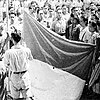Prelude
As World War II ended, the British Army landed in Bali, disarmed occupying Japanese troops, and returned to Batavia. Some Dutch KNIL battalions under Gajah Merah, however, stayed in the city. When Gajah Merah's Infantry landed, Ciung Wanara commander I Gusti Ngurah Rai went to Yogyakarta to discuss Bali's condition with the head of the Republic Indonesian Army (Indonesian: Tentara Republik Indonesia), who placed one ALRI warship in Gilimanuk Harbour.
On 28 May 1946, I Gusti Ngurah Rai led the army's long march to East Bali. Skirmishing began at Tanah Aron on 9 July 1946, moving later to Penglipuran. The long march then resumed until they had arrived at Tabanan. On 20 July 1946, the NICA Y-Brigade first landed at Benoa.
On 11 November 1946, the battalion and defected NICA head police officer Wagimin arrived at Dangin Carik, Tabanan, planning to disarm the regency's NICA Police by the night of 18 November. On that day, the combined 300 men of platoons Barisan Banteng and Anak Banteng arrived with weapons. [7]
Battle
On 19 November, the Y-Brigade arrived at army posts in Perean, Baha, Kediri, Tabanan, Penebel, and Jatiluwih to reach Marga and block the Ciung Wanara battalion's movement. Rai knew about the plan and commanded the battalion to disband, with 95 men remaining with him to commit puputan (last stand) in battle. These remaining troops moved to Banjar Kelaci, Marga.
On the morning of 20 November 1946, KNIL troops arrived before sunrise to block the remnant of Rai's troops as planned. The battle began at 8:00 AM. At first, KNIL troops thought the battalion's defense was too strong, so they fell back.
At 12:00 PM, the Dutch troops were helped by a bomber from Makassar, and resumed the attack after the bombing. The battle ended at 5:00 PM, with 400 Dutch soldiers and the entire remaining Ciung Wanara battalion (including Rai) killed in action. NICA was commanded to bring all of the corpses to the Marga Market, but only 86 bodies were taken. [8] [9] [10]
Since Rai's entire force was wiped out, including the military leadership, the Dutch forces were subsequently unopposed and were able to regain control of Bali. This may not have been possible had Ngurah Rai adopted a guerrilla strategy. [11]
This page is based on this
Wikipedia article Text is available under the
CC BY-SA 4.0 license; additional terms may apply.
Images, videos and audio are available under their respective licenses.
